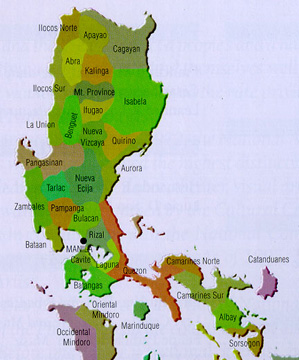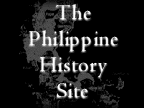Proclamation
of Philippine Independence
and the Birth of the Philippine Republic
With
transportation provided by the Americans, Aguinaldo
and his leaders returned to Cavite. They resumed their
war offensive against Spain and reestablished the
revolutionary government. Because of the exigencies
of the time, Aguinaldo temporarily established a dictatorial
government, but plans were afoot to proclaim the independence
of the country especially since the Spaniards were
reeling from defeat one battle after another.
From
the balcony of his house in Kawit, Cavite, Aguinaldo
declared on June 12, 1898 the independence of the
Filipinos and the birth of the Philippine Republic.
For the first time, the Philippine flag, sewn in Hongkong
by the womenfolk of the revolutionaries, was unfurled.
Two bands played Julian Felipe’s Marcha Nacional
Filipina which became the Philippines’ national
anthem. The declaration further emboldened the fighting
Filipinos.
 On
June 18, 1898, Aguinaldo passed a decree calling for
the reorganization of the provincial and municipal
governments. In her article, Guerrero claims that
following the liberation of Luzon from the hands of
the Spaniards, elections were held in Cavite, Bataan,
Batangas, and Pampanga in June and July; in Manila,
Tayabas (now Quezon), Pangasinan, Ilocos Norte, and
Ilocos Sur in August; in Abra, Camarines Norte, Camarines
Sur, and Nueva Ecija in September; in Nueva Vizcaya
and La Union in October; and in Isabela, Catanduanes,
Albay, and Sorsogon in December. The elected provincial
and town officials were mostly the same local officials
during the Spanish period. This was because the requirements
for voting and nomination to public office were restricted
to those who were "citizens of 20 years of age
or above who were ‘friendly’ to Philippine
independence and were distinguished for their ‘high
character, social position and honorable conduct,
both in the center of the community and the suburb’."
On
June 18, 1898, Aguinaldo passed a decree calling for
the reorganization of the provincial and municipal
governments. In her article, Guerrero claims that
following the liberation of Luzon from the hands of
the Spaniards, elections were held in Cavite, Bataan,
Batangas, and Pampanga in June and July; in Manila,
Tayabas (now Quezon), Pangasinan, Ilocos Norte, and
Ilocos Sur in August; in Abra, Camarines Norte, Camarines
Sur, and Nueva Ecija in September; in Nueva Vizcaya
and La Union in October; and in Isabela, Catanduanes,
Albay, and Sorsogon in December. The elected provincial
and town officials were mostly the same local officials
during the Spanish period. This was because the requirements
for voting and nomination to public office were restricted
to those who were "citizens of 20 years of age
or above who were ‘friendly’ to Philippine
independence and were distinguished for their ‘high
character, social position and honorable conduct,
both in the center of the community and the suburb’."
These
provisions automatically excluded the masses in the
electoral process, and insured continued elite supremacy
of local politics, even by those who were Spanish
supporters and sympathizers during the early phase
of the Revolution. Since the ilustrados had
exclusive control of the electoral process, the provincial
and municipal reorganization merely resulted in perpetuating
elite dominance of society and government. Guerrero
claims that records of the period reveal the composition
of the municipal elite was unaltered and local offices
simply rotated within their ranks.
But
not all areas of Luzon came under the control of the
ilustrados during the Revolution. In some towns,
"uneducated" and "poor" masses
were elected by an electorate who most probably did
not meet the qualifications stipulated in Aguinaldo’s
decree. Guerrero claims that the principalia
or ilustrado local officials of Solano in Nueva
Ecija and Urdaneta in Pangasinan complained over the
election of the "uneducated and ignorant"
who they argued were "totally incapable"
of governing. But this was more of an aberration since
the general picture was one of elite dominance and
the alienation of the masses. Despite Aguinaldo’s
order abolishing three hundred years of Spanish polo
or forced labor, the local elite persisted in demanding
personal services from the people, on top of the taxes
levied against them. In some towns and provinces conditions
were even worse as the elite wrangled among themselves,
especially since Aguinaldo did not clearly delineate
the responsibilities of the elected civilian and appointed
military officials. This leads some historians to
conclude that the masses in towns and countryside
were the eventual victims of what transpired during
the Revolution.
The
American entry into the picture convinced the remaining
fence-sitting ilustrados to support the Revolution.
When rumors of an impending Spanish-American War were
circulating in April 1898, several noted ilustrados
led by Pedro Paterno offered their services to the
Spanish governor-general. Yet when Aguinaldo returned
from exile, several ilustrados serving in the
Spanish militia, like Felipe Buencamino, abandoned
the Spaniards and announced their "conversion"
to the revolutionary cause. Indeed, the resumption
of the revolution brought an electrifying response
throughout the country. From Ilocos in the north down
to Mindanao in the south, there was a simultaneous
and collective struggle to oust the Spaniards.
Months
later, when the Filipino-American War commenced, many
ilustrados played the middle ground, i.e.,
on one hand, they sent words of support to Aguinaldo
and, on the other, started contemplating on an autonomous
status for the Philippines under the United States.
An example was the Iloilo ilustrados who eventually
sided with the Americans since their economic interests
- sugar production and importation - dictated collaboration
with the new colonizers. Indeed, in the parlance of
contemporary Filipino political culture, the ilustrados
were the classic "balimbing" or two-faced.
Despite
the constant vacillation of the elite, Aguinaldo and
his advisers tapped on their services in organizing
the Philippine Republic. Aguinaldo was eager to prove
that the Filipinos could govern themselves, and in
the process it would legitimize the Philippine Republic.
Moreover, since he and his advisers were ilustrados,
Aguinaldo only trusted his own kind - the wealthy,
educated, and politically experienced - in the matter
of governance. Thus, he called on them to convene
and create a Congress which would draft a constitution.
He wanted a Philippine constitution to complete the
required trimmings of a sovereign, nation-state -
flag, army, government, and constitution. In his actions,
Aguinaldo was advised by Apolinario
Mabini who became known as the "Sublime Paralytic"
because his spirit was not deterred by his physical
handicap, and the "Brains of the Revolution"
due to his intellectual acumen. On January 21, 1899,
Aguinaldo proclaimed the Malolos Constitution which was drafted by the
ilustrados of the Malolos Congress. Two days
later, the Philippine Republic was inaugurated in
Malolos, Bulacan, the new capital of the fledging
government.
The
Philippine Republic was, however, short-lived. From
the start, Aguinaldo’s forces were fighting the
Spaniards without military assistance from the Americans.
Except for the Battle of Manila Bay, the United States
was not a major force in the fighting. The American
troops did not arrive in the country until late June,
and they saw no military action until August. But
events starting with the Spanish surrender of Manila
on August 13, 1898, doomed the end of Philippine independence.
Although
the Spanish troops had been routed in all fronts by
the Filipinos, the continuing presence of the Americans
was unsettling. Questions on actual American motives
surfaced with the continuous arrival of American reinforcements.
It did not take long for the Filipinos to realize
the genuine intentions of the United States. The precarious
and uneasy Philippine-American alliance collapsed
on February 4, 1899, when the Philippine-American
War broke out and threatened to annihilate the new
found freedom of the Filipinos.

